
Young olive baboon
[ <<previous | index | next >> ]
18:30
We've had an incredibly full day already, and M. is having a nap before dinner while I type.
Our alarm went off at 06:00, and almost as I was turning it off the phone rang, being reception giving us a wake up call to make sure we made our morning start. We got up and dressed quickly, then headed down to the restaurant, taking everything we needed for the day so we wouldn't have to return to our room before meeting Timba.
The breakfast buffet included eggs to order, plus fried potatoes, baked beans, sausages, bacon, as well as a variety of breads, cereals, fruit, yoghurt. One cereal was a dark muesli which looked very intriguing. I scooped a bunch into a bowl and added yoghurt. When I tried a spoonful, I discovered the muesli was hot! Going back for seconds, as it was so delicious and unusual, I asked what was in it, and the chef replied that it was hand made here at the lodge, using ground weet bix, oats, and some other ingredients, then they bake it. It was so good I even had thirds, forgetting about everything else on offer, except to try one of the local fried dough balls, which had a cinnamon and sugar dusting on the outside and was also pretty good.
Breakfast done, we quickly used the toilets in the reception lobby and then went out to meet Timba, who was waiting there for us. We loaded up the car and set out right on 07:00. The drive was initially back through Karatu and the way we'd come yesterday, until we reached the turn off for Lake Manyara National Park. Just inside the park we stopped at a gate where park staff recorded our names and nationality and then did some other paperwork with Timba while we used the toilets there (as it had been a fair drive already). A few other vehicles with tourists were also in the vicinity. Before we left here, Timba popped up the top of the Land Cruiser, so we could stand up and see out through the opening in the roof, with some protection from the sun above us.
Then we set off into the park, following a dirt road that often branched and headed off in different directions. On the way here I'd asked Timba if we would have the chance to get out and walk around much, or if we essentially stayed in the car. He said we were required to stay in the car, except at designated picnic or toilet spots. He told us to keep an eye out for wildlife as we drove and yell at him to stop if we see anything.
Before long we spotted a troop of olive baboons. It turned out these were the most common thing to see, and we saw many groups of them throughout the day.
 Young olive baboon |
But then we spotted vervet monkeys in the trees, small pale brown monkeys with black faces.
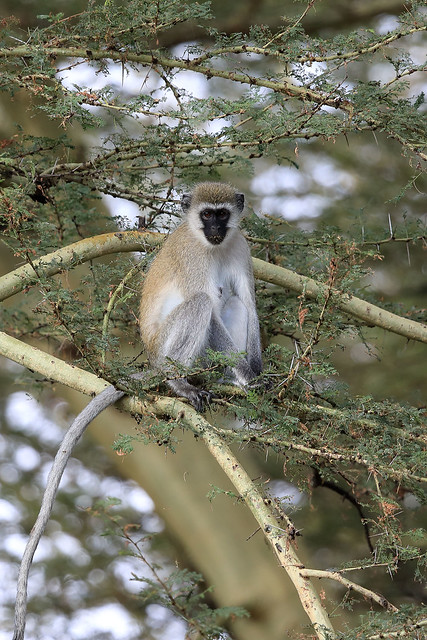 Vervet monkey |
We also saw the larger and darker blue monkeys, though I didn't manage to get a good photo of one until we spotted another late in the day.
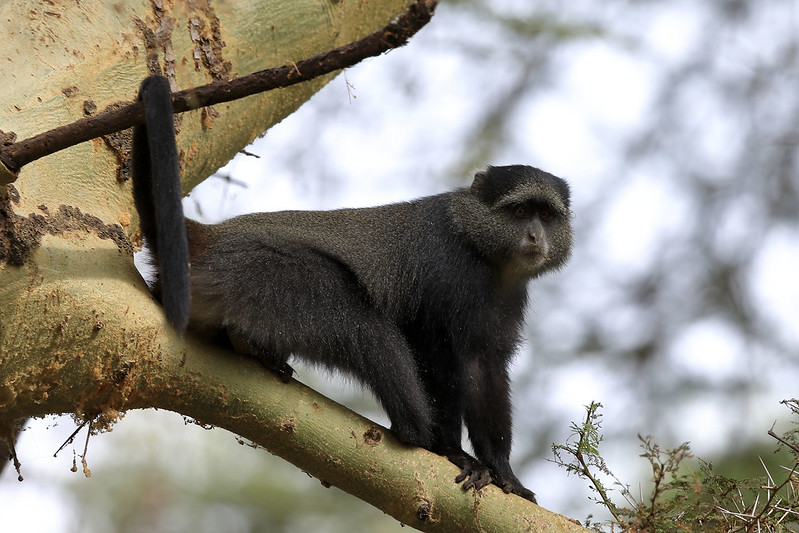 Blue monkey |
And then we saw elephants! Quite close to the road, a mother and a young one. They ambled off unconcerned about our vehicle. It was incredible how close we were able to get.
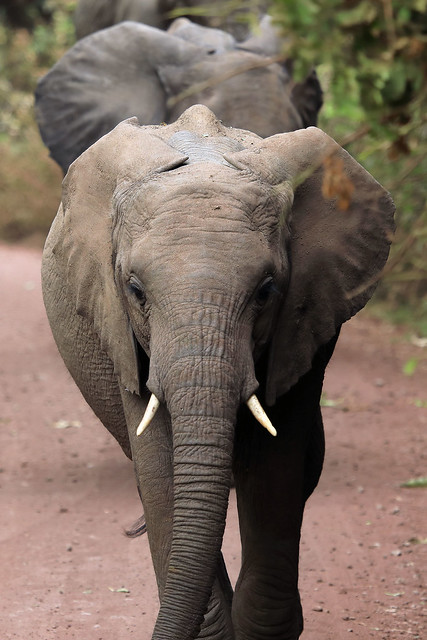 Baby elephant, with mother behind |
The next thing we saw was giraffes, which M. spotted half hidden among the trees and bushes. There were at least four of them, but mostly obscured. Timba said these were Tanzanian or Masai giraffes, a different subspecies to the ones that live on open plains.
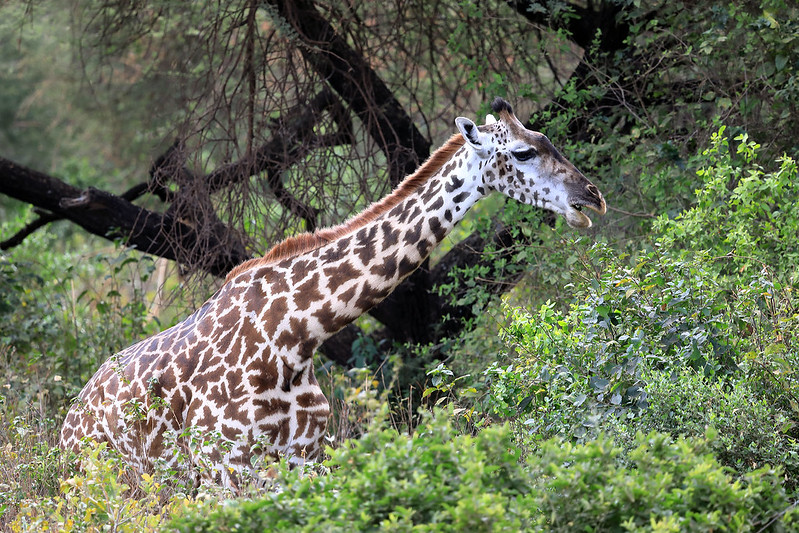 Masai giraffe |
As the day progressed, we spotted Thomson's gazelles and the similar looking Grant's gazelles, warthogs, hippos, wildebeest, a buffalo, impalas, bushbucks, and a pair of tiny dik-diks. At first we thought the tiny dik-diks were baby impalas, but Timba said they were fully grown. We also saw a small animal which Timba described as a type of mouse, poking out of a hole in a termite mound, a rock hyrax sitting on a large rock, and a large monitor lizard also sitting a termite mound.
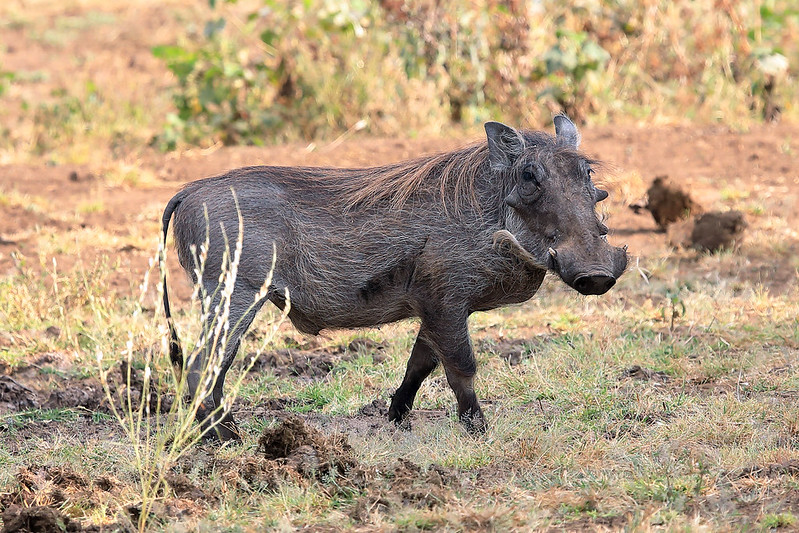 Warthog |
And then there were the birds... so many different types of birds. I can't remember all the species names that Timba gave me as we spotted them, but they included a jacana, an ibis, a stork, a spoonbill, a pelican, two different kingfishers, a bee-eater, a woodpecker, a dove, a hornbill, and many more.
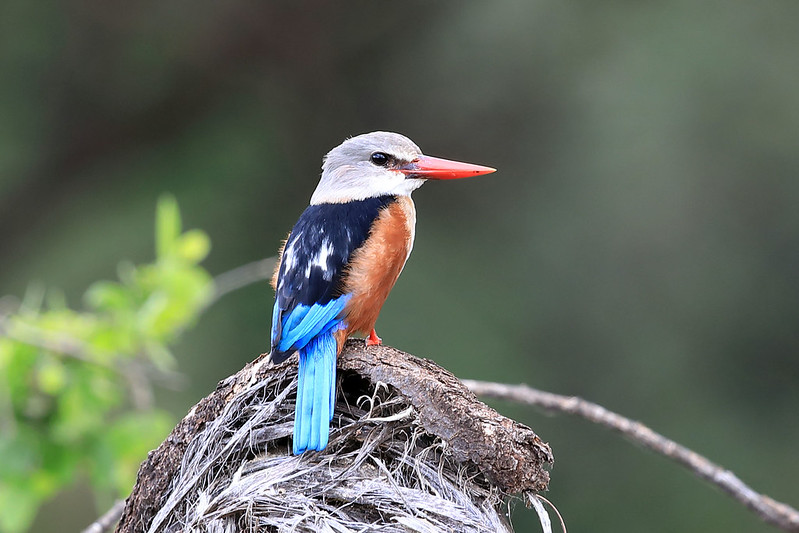 Grey-headed kingfisher |
The hippos we saw wallowing in a large pool, which we approached along a completely submerged road, the Land Cruiser coping easily with the water level. Although we saw another car which was stuck in the water, listing at a nearly 45° angle and abandoned by its occupants. The hippos were almost completely submerged and we only really saw their eyes and ears poking above the water. A bit further along was an observation platform overlooking an area of marsh. We stopped there and stretched our legs by walking around a bit and onto the platform, seeing many of the birds from here.
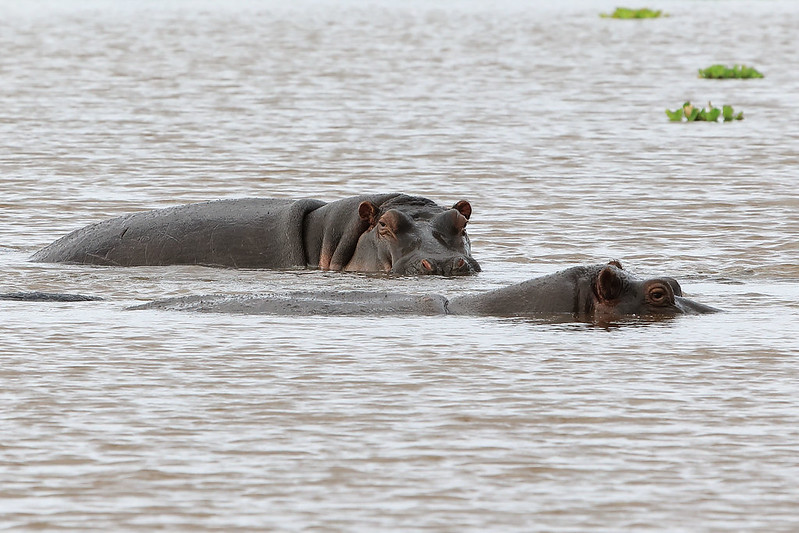 Hippos |
Further on we came across a group of cars all stopped by the side of the road and I strained to see what their passengers were looking at, when Timba cried out "lions!" A freshly killed wildebeest was beside the road, covered in flies, its teeth bared in a rictus of death, and flies swarming over it. A few metres away lounged two lions, which Timba said were not full adults yet. It was impossible to tell if they were male or female at this age. They had eaten part of the wildebeest and were now just relaxing nearby, to continue later. They seemed completely unconcerned abut the gaggle of cars and people nearby.
 Young lion |
Moving on, we encountered several more elephants, getting incredibly close to some of them. I spotted the first lone warthog, and Timba complimented my spotting ability, but later on we saw a large group of them right by the road. M. spotted the dik-diks, which we wouldn't have seen without her, as they leapt away quickly into the bush.
We stopped briefly at a picnic area which had twenty or so large tables and benches, but they were all empty. I realised they would probably fill up at lunch time, which was still at least two hours away. We were here just to use the toilets and then move on again, driving ever deeper into the park. Timba stopped the car to show us the monitor lizard, and a hyrax. Then we drove a large loop around at the end of the drivable park area, nestled snugly between Lake Manyara and the rift valley escarpment, but didn't see much more than another troop of baboons. It seemed most of the interesting wildlife today was nearer the entrance.
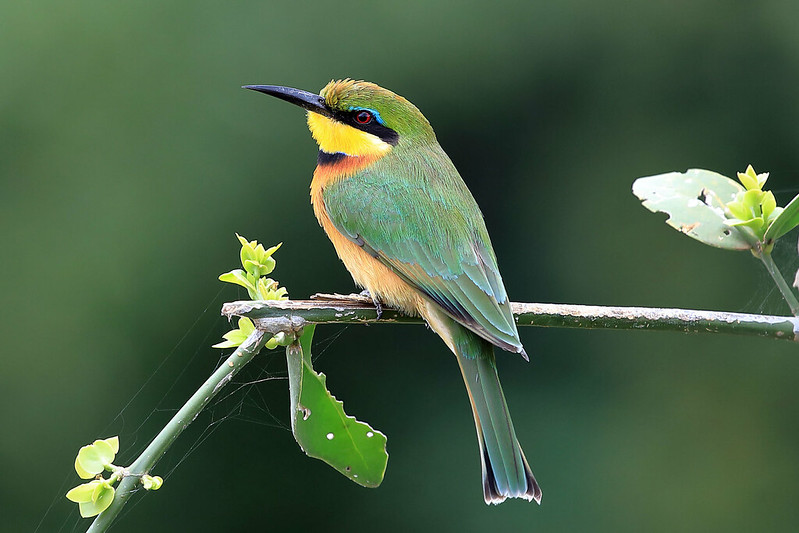 Little bee-eater |
With all the driving, it was getting towards time to head back to Karatu. Timba drove back out of the park at a more rapid pace, not stopping long for new sightings, and passing several other cars. We exited the park after an amazing morning and began the drive back, now slightly tired out by the excitement. As we passed through the corn and sunflower fields again, I asked Timba if there were grape growing regions in Tanzania, to make wine. He said yes, mostly in the Dodoma region further south. We said we'd wanted to try some Tanzanian wines, but had only found South African ones on offer so far. He suggested to ask for Dodoma wines specifically.
We reached the lodge about 13:30, a little earlier than the 14:00 that Timba had quoted to the lodge staff. We wondered if we'd get the same special lunch treatment as yesterday, and lo, Godfrey had indeed set up an outdoor table for us again, this time on the lawn between reception and the gift shop. He settled us in and then fetched the chef to recite today's menu to us. This time it was a man who introduced himself as Victoria, showing us his name badge. He was more hesitant trying to remember what was on the menu today than the lady yesterday. We had a cream of vegetable soup, followed by mains of beef strips cooked in a flavoursome sauce, pasta with vegetables, vegetarian pizza slices, salad, and fries. Again it was all good and all far too much for us to finish, we left a bit of everything. Dessert was, the guy said "fruit salad", but it turned out to be a slice of grilled pineapple with a raspberry sauce.
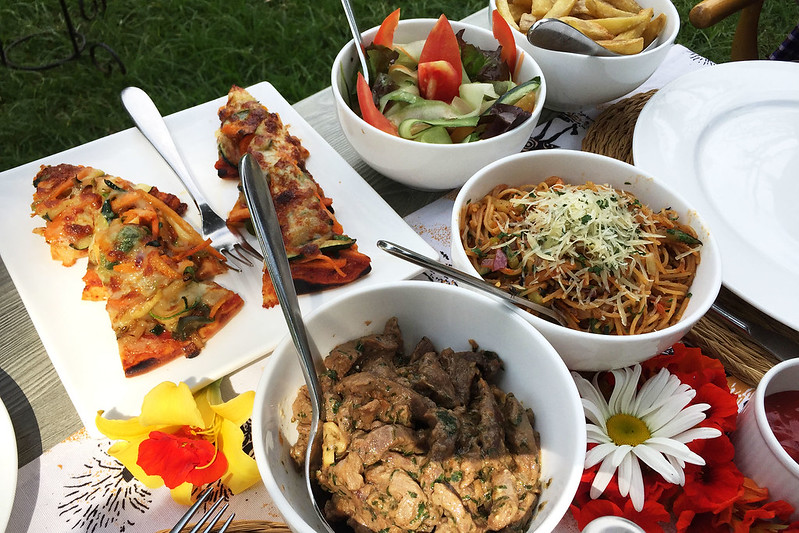 Lunch at Acacia Farm Lodge |
For lunch I'd taken my camera with the long lens so I could photograph any birds we happened to see. It was good that I did, because we saw several birds flitting around the garden, and I got photos of three or four different types, including the yellow ones and the multicoloured ones we'd seen yesterday (later identified as Baglafecht weavers and Fischer's lovebirds).
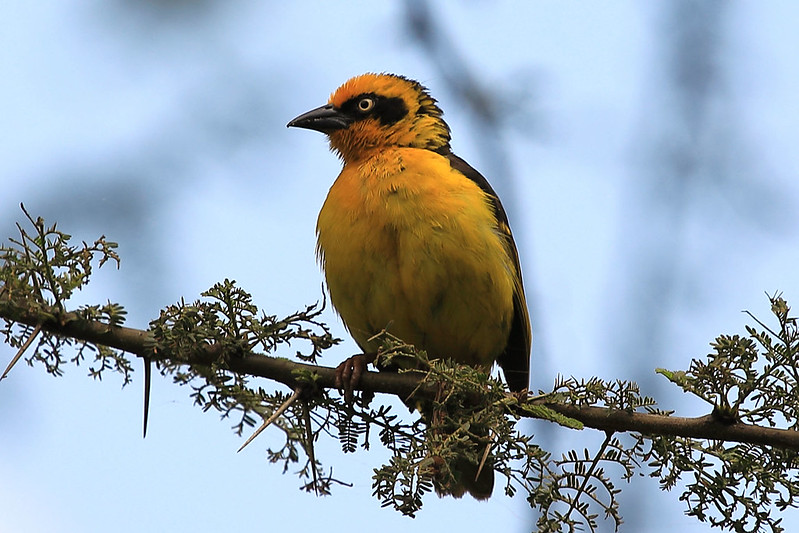 Baglafecht weaver |
Full from the meal, we asked about organising a tour of the Acacia Farm farm, which was one of the activities mentioned in our itinerary. The lodge is built on 25 acres of land, enclosed in a concrete wall, as we learnt during the tour. A large chunk of the land is dedicated to a farm where they grow all of the vegetables used for meals, as well as bananas, papayas, passionfruit, oranges, peaches, and lemons, and possibly some other fruits we didn't see. Our guide was Danny from the lodge staff, and he told us all about the farm as we walked through it on the fertile red soil. This gives us the trifecta of things to declare to customs when we get back home to Australia: being in Africa, walking in wilderness areas, and walking on farms.
Danny began by taking us through the coffee plantation area, which began right outside our own bungalow. All the coffee served here at the lodge is from beans grown on the property. The coffee trees can grow to five metres high, but they keep them trimmed to about the height of a person, so the beans can easily be picked. Mechanised picking cannot be used for coffee beans, so they all have to be picked by hand. We saw the fruits were a mixture of colours from unripe green to ripe red, passing through shades in between, all on the same stalks. Danny said it is almost harvest time, and that pickers will pick the ripe red fruits and leave the unripe ones on the stalks to ripen further over the next few weeks so they can be picked. They pick about once a week until the end of the season in a couple of months.
 Coffee berries on the Acacia Farm trees |
He grabbed a ripe fruit and squished it to pop the coffee beans out of the skin. They looked like coffee beans except they were a pale white colour. He said there are usually two beans per fruit, occasionally one or three. The lodge sends their beans off site to be processed as they don't have the equipment to do it on site. After the beans are removed from the fruit, they are soaked in water for a few days to remove the sugars. After this, the outer skin is peeled off each seed and they are dried out, then finally they are roasted and ground so they can be used to produce coffee.
After walking through the coffee area, we came to the vegetable garden. This was a plot of land about 50 metres square, cultivated in parallel rows with various vegetables: carrots, leeks, onions, broccoli, green and red cabbage, pumpkin, parsley, cauliflower, cucumber, tomatoes (normal, roma, and cherry), and probably a few others. There were also large leafy plants scattered about and Danny asked of we knew what they were. We guessed a random vegetable or two, and then he said they were tobacco plants! They grow them because the leaves are poisonous to insects, so they are a natural form of insect repellent for the farm. A man was working one of the rows, hoeing into the soil. I asked Danny if the soil was very fertile and he said yes, it was very good for growing. He explained that the lodge wanted to be self sufficient. They already grew all the vegetables, and have started adding more fruit trees. Then they want to expand by getting some cows for milk, as well as pigs and chickens. It was all very interesting and impressive.
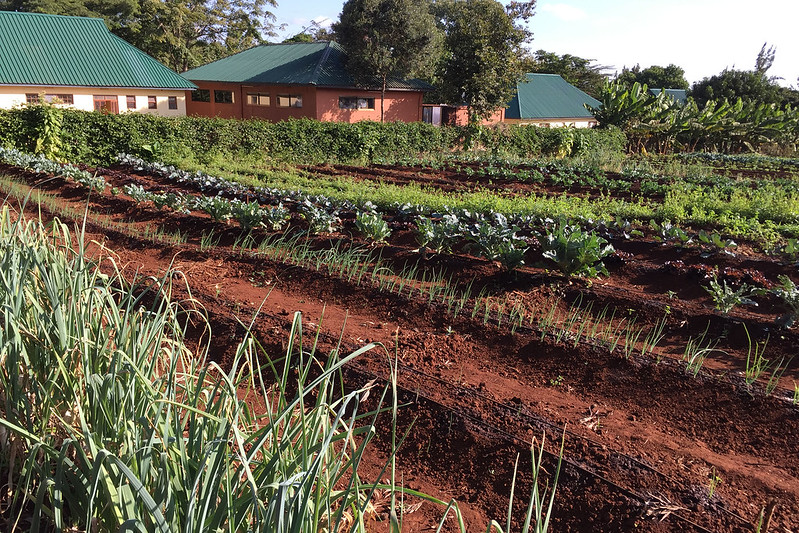 The farm at Acacia Farm Lodge |
Danny also told us about acacia trees. He showed us the thorns on one of them and said that giraffes liked to eat the leaves, but the acacias had other protections apart from just the thorns. When a giraffe starts eating an acacia, the tree reacts by releasing chemical that cause the leaves to change flavour, from sweet to bitter. The giraffe then has to move on. But not only does the tree protect itself, other acacia trees nearby pick up the chemical signal and change their flavour as well. Once the trees start doing this, it can affect all the trees for up to two kilometres, and the giraffes have to move about that far to find new trees to start eating.
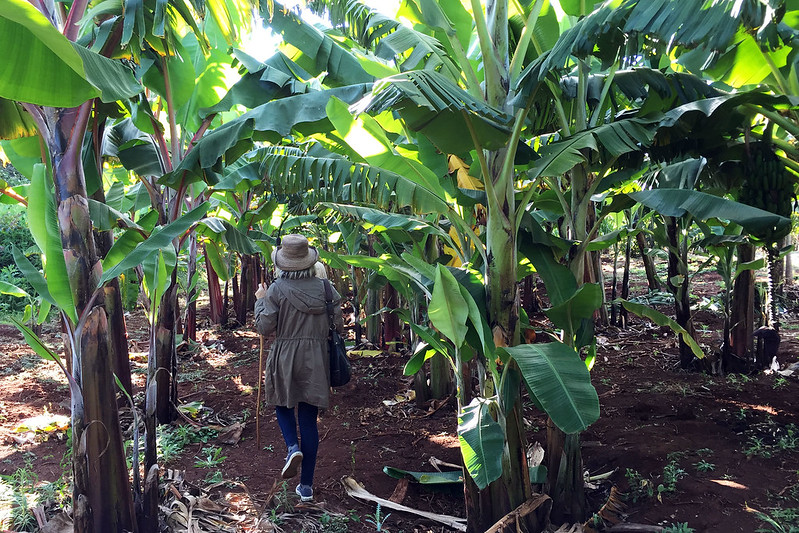 Banana trees at Acacia Farm |
After the farm, he led us along a narrow walking track through wild looking bushland. This was a walk designed to allow bird spotting, as well as butterfly spotting, although Danny said it wasn't butterfly season at the moment (although we did see at least a couple of different types of butterflies, white and yellow ones). He looked carefully and pointed out a dozen or more different bird species, leading me around to get good views so I could photograph them. Originally Danny had said the walk would take about 45 minutes, but we spent almost an hour and a half with him, taking time to look for and photograph lots of birds.
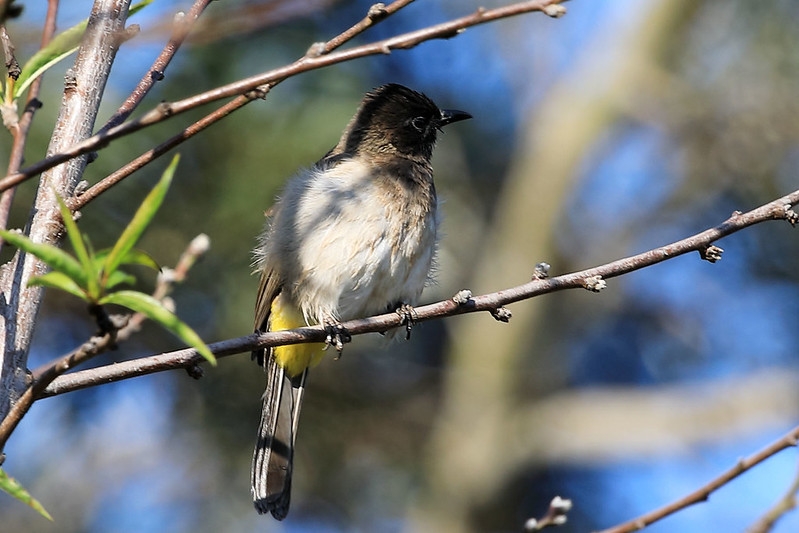 Dark-capped bulbul |
Towards the end of the walk he showed us a traditional mud hut, built near the entrance gate. This was a small building with a thatched roof, inside there were only two small rooms: a tiny kitchen with a loft above it for sleeping, and a slightly larger room which was for keeping animals, such as a single cow or a couple of goats. Danny said the owner of Acacia Farm Lodge had been brought up in such a hut, many years ago. The room for animals was necessary because the Maasai people used to steal animals from other tribes, so it was necessary to keep them inside at night.
The walk ended, we went back to our room to relax for a bit before dinner. Just before 19:00 we emerged into the darkness of the swift tropical night to sit in the reception lobby for a bit and use the WiFi before dinner. Godfrey came out and asked if we wanted a drink. We asked if the lodge had any Dodoma wines. He said they didn't but they had a Chenin blanc from another region of Tanzania, so we both tried that. It was a bit herby and a bit minerally; I liked it. Godfrey also brought us pre-dinner snacks again: chicken wings, cashews, and potato chips.
After the drink and snacks, we moved to the restaurant room for dinner. We expected it to be a buffet again like last night, but instead it was an a la carte selection of appetiser, main, and dessert from a few choices. For the appetiser there was a choice of two salads: a garden salad or an avocado fan, plus a choice of pumpkin soup or something else which I can't remember because we both chose the soup. For mains there were five choices: a beef dish, a chicken, and three vegetarian options, being a vegetable masala curry, fusilli with tomato sauce, or a "local dish" consisting of beans and coconut rice. We selected the green salads, and M. chose the local bean dish, while I picked the vegetable masala. We swapped some of our mains to sample them, and both were good. The dessert choice were a fruit plate or strawberry pannacotta with chocolate sauce. M. chose the fruit while I had the pannacotta. It came as a small heart shaped slab, with the sauce drizzled around in decoratively. One thing about the desserts here is that they have all been modest in size, which is not a bad thing as often I feel like just a few bites of something sweet after a meal, and a large dessert is too much.
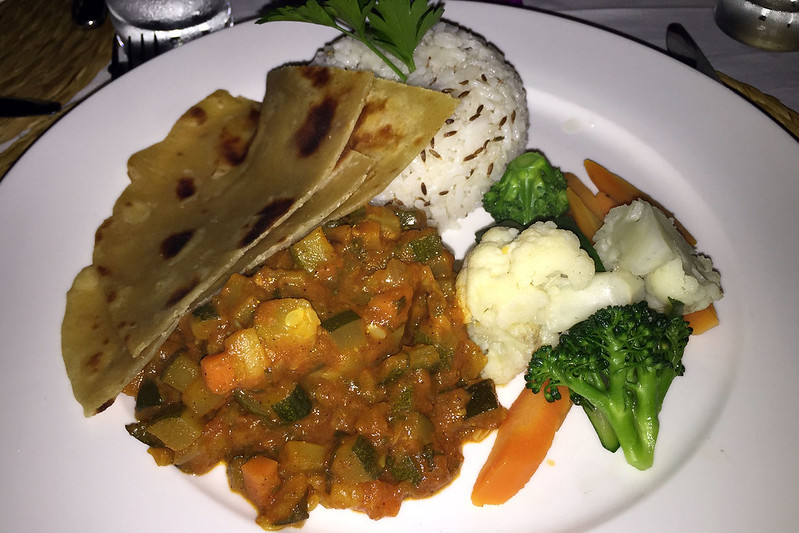 Vegetable masala dinner |
After the dinner, we retired to our room for our final night at Acacia Farm Lodge. We told Godfrey that Timba was picking us up at 08:00, so we would be getting up at 06:30 and coming to breakfast a bit after that.
[ <<previous | index | next >> ]